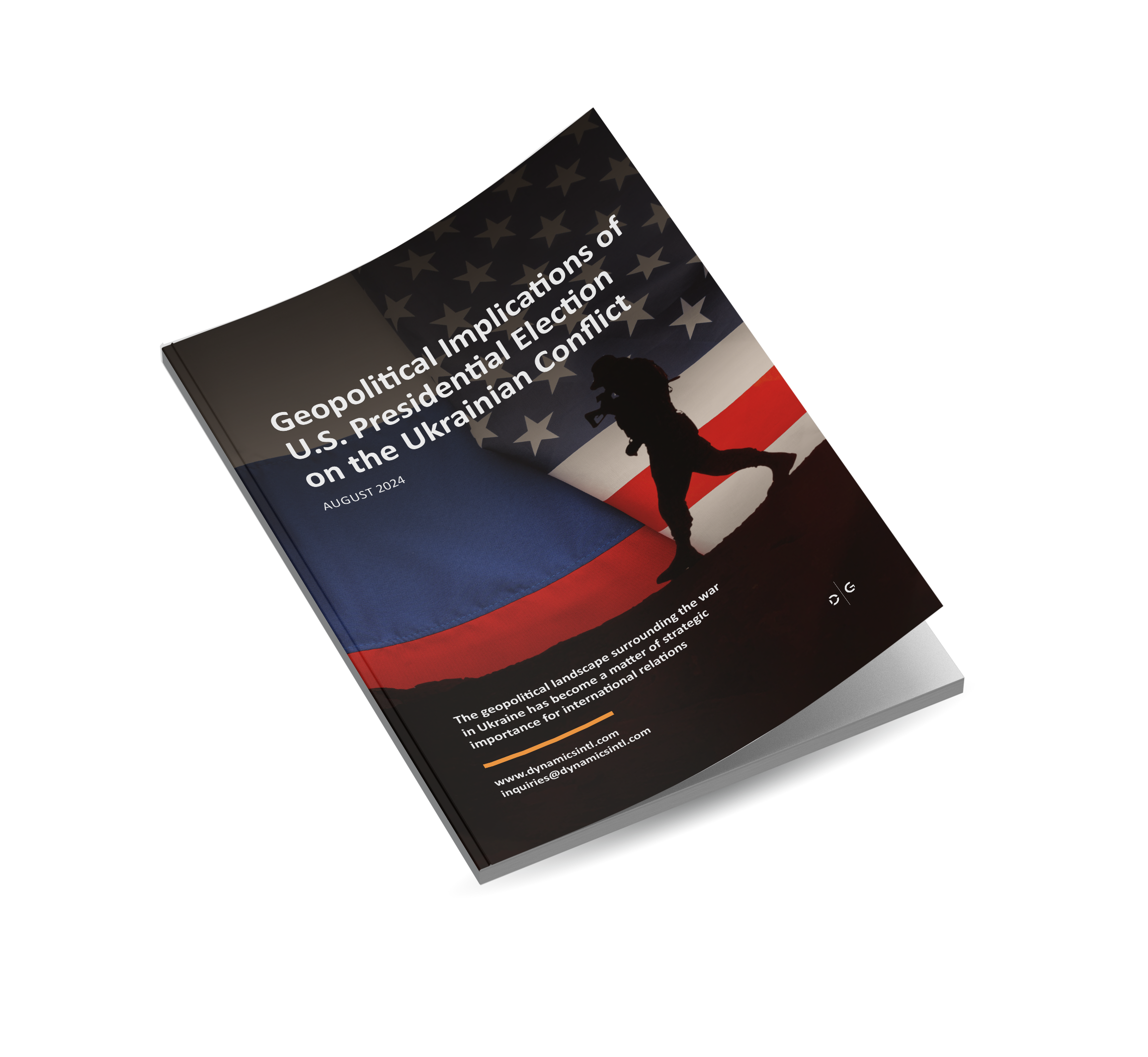Listen to the article – Geopolitical Implications of U.S. Presidential Election on the Ukrainian Conflict
The geopolitical landscape surrounding the war in Ukraine has become a matter of strategic importance for international relations, particularly involving major global powers such as the United States, Russia and key European nations.
The conflict now stands at a turning point: U.S. leadership changes could radically alter its course, while miscalculations on both sides have already reshaped the global geopolitical balance. The upcoming in November 2024 U.S. presidential election is likely to cause major policy shifts regarding the war in Ukraine, which will be contingent upon whether Kamala Harris or Donald Trump secures the presidency.
This following analysis aims to assess the potential impacts of each candidate’s victory on the Ukrainian conflict, evaluating military, economic, diplomatic, and strategic dimensions. In addition, the strategic calculations presented below provide a forecast of possible outcomes under both scenarios and identify key indicators for monitoring the developments.
01
Strategic Assessment
01
Strategic Assessment
Initial assumptions about swift economic collapse and military defeat have proven grossly inaccurate. Instead, the world witnessed a protracted struggle reshaping global alliances with the Global South increasingly siding with Russia. Western unity is put under the test as economic pressures grow and military aid[3] delivers very limited results.
There are several aspects that must be reviewed for comprehending of the entire spectrum of potential implications, including strategic military context of the conflict, economic sanctions’ dynamics, formation of new geopolitical alliances, internal western differences, and, most importantly the differences in approaches of the two US presidential candidates – Kamala Harris and Donald Trump.
1. Military and Strategic Context
The conflict in Ukraine, initiated by Russia’s invasion in 2022, has resulted in significant casualties and prolonged military engagement.[4] Russia’s initial miscalculations regarding the necessary military commitment extended the conflict over two and a half years instead of “a few days” as was planned in the beginning, with substantial human and material costs on both sides.[5] Despite these setbacks, Russia has maintained its strategic objectives through persistent military efforts and economic adaptation.[6]
Western military and economic aid, particularly from the United States, has been and remains fundamental for Ukraine’s defense.[7] However, it did not allowed any significant successes in attempts to liberate the occupied territories. The 2023 counteroffensive[8] did not achieve significant gains clearly demonstrating the limitations of conventional military aid without other geopolitical countermeasures to curtail Russia’s activities.
Additionally, recent statements of some politicians in Europe present conflicting ideas about the timelines for the war’s conclusion.[9] Some suggest that the war will end by 2025 regardless of the U.S. president, with a quicker resolution under Trump, while others believe the conflict will continue beyond 2025, requiring substantial financial support from Western partners.[10] These differing views suggest that either political expediency or financial realities are driving the forecasts.
2. Economic and Sanction Dynamics
Western sanctions intended to weaken Russia had mixed results[11] at best, and as it appears, inadvertently strengthened Russia’s economic resilience.[12] Russia’s GDP growth[13] driven by defense sector expansion and partnerships with China, North-Korea, Iran and even democratic India, demonstrated the limitations of Western strategies. De-dollarization and import substitution policies have further bolstered Russia’s economic stability.[14]
In contrast, the economies of key Western nations went through serious turmoil and challenges. For instance, Germany’s GDP declined[15] by 0.9% in 2023, while the U.S. economy grew by 2.5%, both figures highlighting the economic strain within the Western bloc. This economic disparity between Russia and its Western adversaries questions the effectiveness of the sanctions and clearly points towards the need for strategic reassessment.[16]
3. Geopolitical Alliances and Global South Dynamics
The strategic alliance between Russia and China represents a significant shift in global power dynamics, challenging Western dominance. This partnership extends beyond economic cooperation to include military collaborations, as evidenced by joint military exercises near sensitive regions such as Alaska.[17] Additionally, the emergence of the Global South as a more independent geopolitical entity, often aligning with Russian positions, complicates the Western strategic outlook.[18]
The Global South’s alignment with Russia reflects broader shifts in international relations. Many countries in Africa, Asia, and Latin America have pursued neutral or supportive stances towards Russia, influenced by economic ties, historical relationships, and dissatisfaction with Western policies.[19] This realignment requires more inclusive and cooperative diplomatic efforts from Western powers to counterbalance the ambitions of Russia and China to establish new global order.
4. Western Strategic Missteps and Ukrainian Military Capabilities
Western support for Ukraine through political, economic and military aid, has not yielded decisive outcomes. The much-anticipated Ukrainian counteroffensive in 2023 failed to achieve its prime objective – to secure previously captured by the Russian force’s territories, which showed the limitations of conventional military aid.[20] The sustainability of current support strategies without escalating the conflict or expanding it geographically remains highly questionable.
The potential deployment of NATO forces under various guises, such as private military companies, and the reduction of the conscription age in Ukraine reflect the diminishing strategic options available to the West. These measures suggest an urgent need for enhanced logistics support and advanced defensive technologies to address the strain on Ukrainian military capabilities.
Download Report
Geopolitical Implications of U.S. Presidential Election on the Ukrainian Conflict
The geopolitical landscape surrounding the war in Ukraine has become a matter of strategic importance for international relations, particularly involving major global powers such as the United States, Russia and key European nations.
Recent assessments suggest three possible scenarios[21] for ending the war by 2025: 1) a significant reduction in U.S. support leading to a forced Ukrainian peace deal, 2) a decisive Russian military breakthrough, or 3) internal destabilization in Russia. Each scenario carries its own likelihood and implications, with the first being unlikely given the strategic value the U.S. places on Ukraine as a counterbalance to Russian influence.
5. Internal Western Divisions and Anti-Globalist Trends
Internal divisions within the Western alliance, exacerbated by political shifts[22] in key countries, threaten a unified response to the Ukrainian conflict. The potential return of Donald Trump, along with rising anti-globalist sentiments[23] in Hungary, Slovakia, and potentially France and Germany, indicates a fragmented Western bloc. This fragmentation, partly due to perceived failures in Ukraine undermines the cohesion and effectiveness of the entire alliance.[24]
6. Trump as a Peace Negotiator: Potential and Challenges
Donald Trump’s potential return to the presidency introduces a different dynamic to the Ukrainian conflict. Trump has made bold claims about achieving peace in Ukraine swiftly, yet these assertions lack a concrete, articulated plan. The feasibility of such a peace depends on several factors:
- Lack of a Clear Plan: Trump’s assertions[25] about achieving peace lack a detailed, actionable plan. Without a documented strategy, his promises remain speculative and uncertain.
- Influence on Ukraine vs. Russia: Achieving peace would likely require significant concessions from Ukraine, a move over which the U.S. has some influence.[26] However, the U.S. has limited leverage over Russia, which controls the critical decisions.
- Internal Opposition: Trump’s potential efforts to negotiate peace may face substantial opposition from the deeply entrenched globalist establishment and the Democratic Party, which are heavily invested in the current Ukrainian policy.[27]
- Negotiation Leverage: Unlike the Biden administration, Trump may have more flexibility in negotiations with Moscow. This does not guarantee a “grand deal” but increases its theoretical possibility.[28]
- Ukraine’s Resource Constraints: Ukraine’s diminishing resources and capability to sustain the current level of conflict make some form of peace, regardless of its quality, increasingly likely.[29] This reality underpins the urgency for a resolution, which could manifest under Trump’s administration due to a lack of a coherent long-term U.S. strategy.
Trump’s potential peace plan, if it exists, is likely to involve substantial concessions from Ukraine. His statements about achieving peace swiftly suggest a willingness to pressure Ukraine into making significant compromises, potentially accepting Russian control over certain territories. However, this approach faces significant challenges, including resistance from the globalist establishment, limited U.S. leverage over Russia, and the complexities of negotiating a durable peace agreement.
The scenario analysis highlights that the first scenario, where the U.S. reduces support and forces Ukraine into a peace deal, is unlikely given the strategic importance the U.S. places on containing Russian influence through Ukraine. Trump might attempt to shift more financial responsibility to European allies, but outright abandonment of Ukraine is improbable.
7. Harris’ Strategic Approach
A Harris presidency would likely continue the Democratic Party’s established policies but with some adjustments. Key elements of her strategy might include:
- Controlled Escalation: Harris might pursue a controlled escalation strategy to pressure Russia into negotiations, portraying any resulting ceasefire as a diplomatic victory. This could involve increased military aid or limited NATO involvement.[30]
- Strategic Concessions: Pragmatic shifts towards accepting some Russian territorial gains such as Crimea and parts of Donbas in exchange for a broader ceasefire, could be a possible strategy.[31] This, however, would require a significant change in Western rhetoric and policy.
- Economic and Diplomatic Pressure: Continuation and adaptation of sanctions regimes and efforts to prevent Russia from normalizing relations with key European countries could become critical.[32]
- Western Unity: Maintaining unity within the Western alliance will be absolutely crucial, involving diplomatic initiatives and strategic economic incentives.[33]
- Global South Engagement: Harris might focus on engaging the Global South more effectively to counterbalance Russian influence, involving increased economic and development aid.[34]
Harris’ approach would likely emphasize a combination of controlled escalation and strategic concessions to achieve a diplomatic resolution. Her administration might seek to pressure Russia into negotiations through increased military aid and limited NATO involvement while simultaneously pursuing pragmatic concessions to secure a broader ceasefire.
Considering the second scenario, where Russian forces achieve a breakthrough, it seems equally unlikely as long as Ukrainian defenses hold and Western support remains robust. The third scenario, involving internal destabilization in Russia, remains highly speculative and currently shows no significant signs of materializing.
8. The Role of Strategic Miscalculations
Both the Western and Russian sides have made significant strategic miscalculations in the Ukrainian conflict. For Russia, the initial underestimation of the required military commitment led to a prolonged and costly engagement. For the West, the sanctions strategy, while intended to weaken Russia, has had the unintended consequence of strengthening its economic resilience and fostering closer ties with China and the Global South.
These strategic miscalculations have shaped the current geopolitical landscape and will continue to influence future developments.
02
Predictions and Indicators
02
Predictions and Indicators
The following is a combined prediction of potential policy trajectories for a Harris or Trump presidencies based on the underlying logic of the above analysis, historical precedent, already evident campaign rhetoric and broader geopolitical context. It provides key expectations and indicators that would precipitate the materialization of each prediction.
Under Harris Administration
1. Controlled Escalation and Diplomatic Maneuvering: A Harris administration might opt for a gradual increase in military aid and limited NATO involvement to strengthen Ukraine’s position while simultaneously pursuing diplomatic channels to force Russia to the negotiating table.
Indicators:
- Increased military aid: A substantial increase in military assistance beyond current levels would suggest a more aggressive stance.
- NATO troop movements: Deployment of NATO troops to countries bordering Ukraine would indicate a heightened level of military involvement.
- Diplomatic activities: Active engagement in peace talks and mediation efforts coupled with public statements emphasizing diplomacy would signal a parallel track to military pressure.
- Backchannel negotiations: Evidence of discreet diplomatic channels with Russia, perhaps through intermediaries such Turkey, France, Switzerland, China, Saudi Arabian, etc., would suggest an attempt to find various forums and settings to explore potential compromises without public confrontation.
2. Strategic Concessions and Territorial Compromises: Due to the prolonged nature of the conflict and potential domestic pressures, a Harris administration might consider accepting some territorial losses for Ukraine in exchange for a ceasefire and a commitment from Russia to cease the hostilities.
Indicators:
- Changes in Western rhetoric: A shift in public discourse from emphasizing territorial integrity to acknowledging the possibility of territorial adjustments would be a significant indicator.
- Backchannel negotiations: Intensive diplomatic efforts focused on territorial boundaries and potential trade-offs would signal a serious consideration of this option.
- Public opinion shifts: A decline in public support for continued military aid or a growing acceptance of territorial compromises could influence decision-making.
3. Sustained Economic and Diplomatic Pressure: This strategy involves maintaining existing sanctions, potentially tightening them and isolating Russia diplomatically.
Indicators:
- New sanctions: Imposition of additional economic penalties, targeting specific sectors or individuals, would indicate a continuation of this approach.
- Diplomatic isolation: Efforts to prevent Russia from participating in international forums, or to reduce its influence in global institutions, would be key indicators.
- Creating coalition(s): Strengthening already existing alliances and creating new partnerships to enforce sanctions and isolate Russia would indicate a sustained commitment to this strategy.
4. Maintaining Western Unity: A Harris administration would likely prioritize preserving Western unity to effectively counter Russian influence. This would involve addressing internal divisions within the Western bloc and strengthening alliances.
Indicators:
- Diplomatic overtures: Increased diplomatic activity among Western allies, particularly with European partners to address shared concerns and coordinate policies.
- Economic incentives: Offering economic incentives or concessions to reluctant allies to maintain their support for the Ukraine policy.
- Public diplomacy: Efforts to build public support for the Ukraine policy within Western countries through public speeches, media campaigns, and other communication strategies.
- Internal policy adjustments: Making concessions to domestic constituencies that oppose the Ukraine policy to reduce internal dissent.
5. Adaptation to Global South Dynamics: Recognizing the growing influence of the Global South, a Harris administration would likely seek to engage these countries to counterbalance Russia’s influence and build new partnerships.
Indicators:
- Increased aid packages: Allocating significant financial resources to development and humanitarian assistance programs in Global South countries.
- Diplomatic visits: High-level visits by U.S. officials to key Global South countries to strengthen bilateral relations.
- Multilateral engagement: Active participation in regional and international organizations focused on Global South issues.
- Economic partnerships: Initiating new trade and investment agreements with Global South countries to enhance economic cooperation.
Under Trump Administration
1. Trump’s Potential Peace Strategy: If A Trump administration is likely to prioritize a swift end to the conflict, potentially at the expense of Ukrainian interests. This could involve significant concessions from Ukraine to secure a peace deal.
Indicators:
- Direct negotiations: A push for direct negotiations with Russia, bypassing traditional diplomatic channels.
- Reduced military aid: A significant decrease in military assistance to Ukraine.
- Public statements: Rhetorical emphasis on the costs of the conflict and the need for a quick resolution.
- Isolation of allies: A tendency to disregard the opinions and concerns of European allies.
Shared Implications
The policies of both Harris and Trump will have significant implications for NATO and European security.
1. Impact on NATO and European Security: Harris might pursue a more traditional approach, emphasizing the importance of NATO alliances and collective security. Trump might advocate for a more transactional approach, potentially leading to shifts in NATO dynamics and European security policies.
Indicators:
- NATO spending: Changes in defense spending by NATO member states.
- NATO troop levels: Adjustments to troop levels in Eastern Europe.
- NATO decision-making: Shifts in decision-making processes within the alliance.
- European defense initiatives: Development of independent European defense capabilities.
2. Long-Term Economic and Political Stability in Ukraine: The policies of the U.S. president will have a profound impact on Ukraine’s long-term trajectory.
Indicators:
- Economic aid: Levels of economic assistance provided to Ukraine.
- Political support: Public statements and diplomatic actions expressing support for Ukrainian sovereignty and territorial integrity.
- Anti-corruption efforts: Support for anti-corruption reforms in Ukraine.
- Democratic consolidation: Support for democratic institutions and processes in Ukraine.
03
Conclusion
03
Conclusion
The resolution of the Ukrainian conflict depends on the strategic decisions made by the next U.S. president.
If Kamala Harris secures the presidency, her approach will likely involve a combination of controlled military escalation and strategic concessions aimed at achieving a diplomatic resolution. This strategy would focus on sustained economic sanctions, diplomatic isolation of Russia, and efforts to maintain unity within the Western alliance while engaging more effectively with the Global South.
A Trump victory could lead to an immediate push for peace through direct negotiations, potentially involving substantial concessions from Ukraine. Trump’s approach may prioritize a swift resolution over long-term stability, leveraging a more flexible negotiation stance with Russia. This could lead to a peace settlement, but with significant uncertainties and potential compromises that might not address all underlying issues of the conflict.

ARTICLE | 22 PAGES




